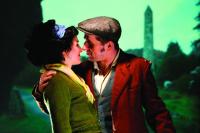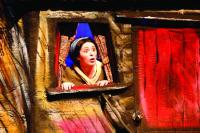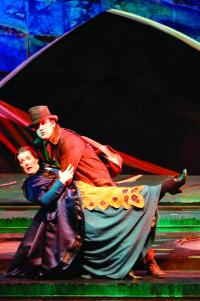Arrah-na-Pogue
Published in 18th–19th - Century History, Issue 2(March/April 2011), Reviews, Volume 19
The plot revolves around the fidelity and decency of the common people represented by Arrah Meelish (Mary Murray) and her lover, Shaun the Post (Aaron Monaghan).
The enduring popularity of the Victorian melodramas of Dion Boucicault, especially his major Irish plays, is a tribute to their ability to survive changing theatrical tastes. The plays lend themselves to high-speed performance and broad characterisations, which are nowadays played for comic effect. An actor-manager-playwright with a talent for riding the wave of popular taste, Boucicault made a huge impact on the theatre in mid-nineteenth-century New York and London, before doing the same thing in his native Dublin. One of his biggest hits, The poor of New York of 1857 (which was variously adapted as The poor of Liverpool, The poor of Dublin, etc., depending on where it was performed), dramatised the consequences of the financial crises of the 1850s, and also confirmed Boucicault’s reputation as a master of spectacular special effects. Audiences were impressed by effects such as a burning tenement building on stage in The poor of New York, or an exploding river-boat in The Octoroon; or life in Louisiana (1859), which is also distinguished as the first play to represent a black person as a serious character on the American stage.
Similar extravagances mark Boucicault’s major Irish plays—The Colleen Bawn, Arrah-na-Pogue and The Shaugraun. Their success lay partly in Boucicault’s ability to combine racy and entertaining melodrama with contemporary social concerns. This formula also proved successful when Boucicault adapted Gerald Griffin’s novel The Collegians for the stage. Griffin’s novel was a fictionalised version of the murder of Ellen Hanley, the daughter of a small farmer, by her husband, a Limerick landowner, and his servant in 1819. The story also inspired Julius Benedict’s opera The Lily of Killarney (1862). The Colleen Bawn was an extraordinary success when it opened in New York in 1860; when it moved to London in the same year it was the biggest success for decades and was seen by Queen Victoria. It was most recently revived in Dublin at the Project last August. ‘When I wrote the Colleen Bawn, I invented the Irish drama. It was original in form, in material, in treatment and in dialogue.’ The importance of these plays for the history of the Irish theatre is borne out by Chris Morash’s point that before Boucicault the Dublin stage was dominated for decades by operas with no Irish reference.

The redeeming virtues of the play’s world are located much more visibly in Arrah (Mary Murray) and Shaun the Post than in the aristocratic characters.
Boucicault’s talent was reflected in the popularity of his Irish plays with both British and Irish audiences. This was despite the fact that Arrah-na-Pogue (1864) and The Shaugraun (1874) were both set against the background of Irish rebellion. Boucicault can be seen as the re-inventor of the theatrical image of the Irishman and also as the playwright who marked a new beginning for the Irish theatre in the middle of the nineteenth century. Despite the distaste of many in the Irish literary revival, which took off after his death in 1890, for the style and tone of his work, Boucicault’s Irish plays presented a much more favourable image of the Irish peasant and the Irish gentleman than the existing tradition exemplified by characters such as Sir Lucius O’Trigger and Thady O’Blarney.
Like The Colleen Bawn, Arrah-na-Pogue is set in the picturesque Irish landscape that was becoming widely known through tourist guidebooks in the middle of the nineteenth century. But this is also the insurrectionary Wicklow of the 1798 rebellion, and the plot revolves around the fidelity and decency of the common people represented by Arrah Meelish and her lover, Shaun the Post. The dangers of the plot turn on the pursuit of the rebel leader, Beamish Mac Coul (the Mac Coul), by the villainous process-server Michael Feeney, representing the gombeen element in Irish society, Major Coffin, representing British power, and Colonel Bagenal O’Grady. O’Grady is Beamish’s rival for the hand of Fanny Power of Cabinteely and a magistrate, but he is also an Irishman. O’Grady is a man of honour, more concerned with justice than with taking the part of Feeney’s plot to convict Shaun the Post and the Mac Coul. In the Abbey production he is a decent but slightly bewildered liberal, contrasting with the wholly confused figures of British authority and the vengeful peasant Feeney. Like the figure of Myles Na Coppalleen in The Colleen Bawn, the character of the faithful servant is central to the play. Beamish’s loyalty to his country—‘my own land! My own land! Bless every blade of grass upon your green cheeks!’—is complemented by the ancient loyalties of Arrah, a vivid example of the strength of what academic historians describe as the moral economy:
‘I’m proud to stand anywhere beside yourself Master Beamish; and sure isn’t the cabin there your own anyway? ’Twas your gift to my mother that nursed you. You were fostered under that old thatch itself, and if they tuk and hung me to the durepost beyant, sure my life ’ud be the only rint we ever paid The Mac Coul for all the blessin’s we owe the ould family.’

Fanny Power (Mary O’Driscoll) and Beamish Mac Coul (Rory Nolan). Beamish’s loyalty to his country is complemented by the ancient loyalties of Arrah, a vivid example of the strength of what academic historians describe as the moral economy.
(All images: Colm Hogan)
The moral order of Boucicault’s peasants and gentry ultimately triumphs over the letter of the law, but the redeeming virtues of the play’s world are located much more visibly in Arrah and Shaun the Post than in the aristocratic characters. The emotional high point of the play was the singing of ‘The wearing of the green’ at the wedding of Arrah and Shaun, as opposed to the theatrical high jinks such as the cross-country horse chase or the spectacle of the tower scene towards the end, where typically elaborate machinery is used to create one of Boucicault’s dramatic special effects. Mikel Murfi’s production also exploited the comic potential of the stage Englishman in which the play abounds—Major Coffin, the sergeant, the Dublin Castle Secretary and his servant Winterbottom, the latter hilariously eloquent on the prospect of getting any rest: ‘No Hinglishman hexpects hanny, my lord, in this country. It keeps us hall hup, and continually deprives Hingland of her natural rest.’ Boucicault’s canny genius explains why the play could, with suitable modifications, be a hit in England and Ireland, and why it continues to fill the theatres in both countries. HI
















